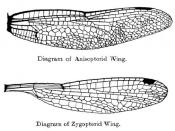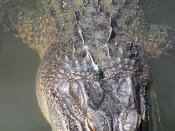taxonomy, evolutionary history, ecology, distribution, morphological characteristics, behavioral characteristics, reproduction, and conservation. Also has pictures and 9 sources
Odonata:
The Dragonfly
The dragonfly is an insect of the order Odonata, which translates into "toothed jaws" and also includes the damselfly. Odonata are an order of aquatic predatory insects. There are currently about 6500 extant species Members of this order are usually large predatory insects that hunt by sight and have chewing mouthparts and four membranous, veined wings. They are strong fliers and when they rest their wings spread out horizontally. They have elongated bodies and many are brilliantly colored. Species live throughout the world except in the polar regions with the greatest variety in the tropics. They are usually found at or near fresh water and yet some species roam widely and may be found far from their breeding sites. Dragonflies are often called horse stingers and devil's darning needles yet they neither sting or bite and all species are harmless (1).
In fact, dragonflies are beneficial to humans because they assist in the control of insect pests.
In some countries, mainly Japan, the Dragonfly has been a popular subject or art and culture, and rank with butterflies and birds as a topic of popular scientific interest (2). Many inland fishermen also use the dragonfly's larvae (known to them as "mud eyes") as bait. Dragonflies also serve as a minor food item in some countries but mainly they are just pleasing to the eye and are of little economic importance.
Taxonomy and Evolutionary History
Dragonflies belong to the Phylum Arthropoda, Subphylum Uniramia, Class Insecta, Subclass Pterygota, and Order Odonata. Dragonflies and Damselflies are both in Odonata. Dragonflies are also closely related to Order Ephemeroptera which includes mayflies and Order Orthoptera which includes grasshoppers and crickets. There are many different...


